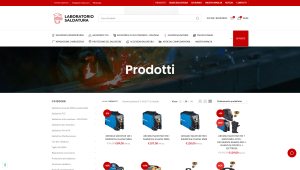What is Search Intent?
Understanding search intent is crucial for the success of any online marketing strategy. Search intent refers to the primary motivation that drives a user to perform a particular query on a search engine. Whether it’s finding information, navigating to a specific website, evaluating products, or making a purchase, every search is driven by a clear purpose.
Ignoring search intent can lead to ineffective marketing campaigns and a waste of valuable resources. On the contrary, aligning your content and offerings with the user’s intent allows you to provide an optimal browsing experience, improving engagement, conversion, and, ultimately, business results.
There are four main types of search intent that are essential to understand and comprehend:
- Informational
The user is seeking specific information on a topic, such as “how to cook pasta” or “flu symptoms.”
- Commercial
The user is in the evaluation phase of a product or service, for instance, searching for “best laptops 2023” or “Rome hotel reviews.”
- Navigational
The user is trying to reach a specific website or page, for example, typing “Facebook” or “Amazon.”
- Transactional
The user intends to perform a specific action, such as a purchase or booking, searching for example “buy iPhone 14” or “book Rome-London flight.”
Understanding these different types of intent is crucial for creating effective digital marketing content, ads, and strategies. For example, for informational searches, it might be useful to create in-depth guides or tutorials, while for commercial searches, promotional landing pages or product comparisons might be more appropriate.
Ignoring search intent means risking providing irrelevant content or advertising to the user, compromising the overall experience and potentially driving away potential customers. On the contrary, carefully considering search intent can lead to more targeted, relevant, and successful marketing campaigns.
How to use search intent for your business
Practical strategies to align your offer with the real needs of your potential clients.
Identifying Search Query Intent
Correctly identifying the search intent behind a specific query is essential for creating effective digital marketing content and strategies. Here are some key steps to determine the intent behind user searches:
Analyze the keywords used
The keywords used in the query provide valuable clues about the user’s intent. For example, searches containing terms like “how,” “guide,” “tutorial” suggest an informational intent, while words like “buy,” “price,” “discount” indicate a transactional intent. Carefully analyzing the keywords is the first step in understanding the motivations behind the search.
Consider the stage of the buying cycle
Search intent is closely tied to the stage of the buying cycle the user is in. General, informational searches are typical of the initial awareness stages, while more specific searches for products or services indicate an evaluation or imminent purchase stage. Keeping this connection in mind can help accurately pinpoint the intent.
Use related search tools
Tools like Google Ads’ Keyword Planner or Google Trends can provide valuable insights into related searches performed by users. By analyzing these related queries, you can gain a broader understanding of the overall intent and context of the original search.
For example, if a user searches for “Nike running shoes,” tools like the Keyword Planner might show related searches like “Nike shoes on sale,” “Nike stores near me,” or “Nike basketball shoes.” These related searches could suggest a commercial or transactional intent, indicating that the user might be interested in purchasing Nike shoes.
On the other hand, if the related searches were more informational, such as “history of Nike” or “Nike shoe technology,” the intent might be more informational or general research.
In addition to Google tools, you can also analyze internal website search data, such as queries used in the site’s search engine or keywords that drove traffic. These insights can help better understand the intent of users visiting your site.
Correctly identifying search intent requires a careful analysis of keywords, context, and related searches. By combining these techniques, you can create a more targeted and relevant digital marketing strategy, providing users with an optimal browsing experience aligned with their actual search intentions.

Optimizing Content for Search Intent
Once you have identified the search intent of your users, the next step is to create targeted and optimized content to best satisfy the different types of intent. Here are some key strategies for optimizing content based on search intent:
- Informational Intent: Guides, Tutorials, Articles
For informational intent searches, it is crucial to provide comprehensive, in-depth, and valuable content. Practical guides, detailed tutorials, and informative articles are great formats to satisfy this type of intent. The goal is to thoroughly answer users’ questions and position yourself as an expert authority on the topic.
- Navigational Intent: Optimize Presence in Search Results
For navigational searches, where the user is trying to reach a specific website, SEO optimization plays a critical role. Ensuring that your website is easily accessible and well-positioned in search results for your brand, product, or service name is crucial. Additionally, a clear and intuitive navigation structure on your site can improve the user experience.
- Commercial Intent: Promotional Content, Landing Pages
For commercial intent searches, where users are evaluating product or service options, it is important to provide persuasive and promotional content. Optimized landing pages, product comparisons, reviews, and sales content can be highly effective at this stage. The goal is to highlight the advantages and benefits of your products or services over the competition.
- Transactional Intent: Simple Checkout, Clear Calls-to-Action
When a user has a transactional intent and wants to make a purchase or booking, it is essential to offer a seamless and obstacle-free checkout experience. Ensure that the purchase process is intuitive, with clear and prominent calls-to-action on all relevant pages. A complicated or confusing checkout can lead to abandoned carts and lost conversions.
Regardless of the type of intent, it is always advisable to optimize content for voice search and mobile devices, as more and more users are performing searches from smartphones and using voice assistants. Adapting your content to these channels can improve the overall user experience.
Remember that users may be at different stages of the buying cycle and have varying search intents. Therefore, it is important to create a comprehensive content strategy that satisfies all types of intent, guiding users through the entire purchase journey.
Measuring Results
After creating content optimized for different search intents, it is crucial to measure the effectiveness of your strategies in order to make any necessary improvements. Here are some key steps to measure results:
- Set Goals and KPIs for Each Intent Type
Before launching any campaign or initiative, it is essential to define clear goals and key performance indicators (KPIs) for each type of search intent. For example, for informational intent, goals could include increased organic traffic, increased time spent on site, or reduced bounce rate. For transactional intent, relevant metrics might be the conversion rate, average order value, or generated revenue.
- Analyze User Behavior Data
Carefully analyzing user behavior data can provide valuable insights into the effectiveness of your content in relation to search intent. Tools like Google Analytics allow you to monitor metrics such as navigation flow, most visited pages, session duration, and bounce rates. This data can reveal whether users are finding your content relevant to their search intentions or if they are abandoning your site prematurely.

Web Analytics Tools and A/B Testing
In addition to standard analysis tools, it is advisable to leverage more advanced tools such as A/B testing and conversion optimization tools. A/B tests allow you to test different versions of content, layouts, or calls-to-action to determine which version works best for a particular search intent. Conversion optimization tools, on the other hand, can help identify any bottlenecks or drop-off points in the user conversion journey.
In addition to quantitative data, it can be useful to collect qualitative user feedback as well, for example through surveys or interviews. This information can provide further insights into their experiences, frustrations, or preferences regarding the content offered.
It is important to constantly monitor results and make regular optimizations based on the data collected. As user needs and intentions evolve, your content and strategies will also need to adapt accordingly.
Measuring the effectiveness of your digital marketing initiatives in relation to search intent is essential for maximizing return on investment and delivering an optimal user experience. By combining clear goals, data analysis, and continuous testing, you can continuously refine your strategy and keep pace with users’ ever-changing expectations.
Future Trends and Developments
While current techniques for identifying and satisfying user search intent remain valid, it is important to consider future trends and developments that could revolutionize this field.
Artificial Intelligence and Machine Learning for Intent Analysis
Artificial intelligence (AI) and machine learning are already beginning to revolutionize the way we understand and analyze search intent. Thanks to natural language processing and automated learning capabilities, AI models can analyze user queries in a much more sophisticated way compared to traditional keyword-based methods.
These models (also local LLM’s) can consider context, implied language, and even the tone of searches, allowing for a deeper understanding of the underlying intent. For example, an AI might identify that a search like “romantic restaurants near me” has a booking or experience intent, rather than just an informational one.
As AI becomes more advanced, it could be able to anticipate user intentions even before they perform an explicit search, paving the way for even more personalized and relevant browsing experiences and content.
Reduced Use of Google and Increased Use of AI for Search
Another emerging trend is the potential reduction in the use of traditional search engines like Google in favor of AI-based virtual assistants. With the advent of assistants like Alexa, Siri, and ChatGPT, more and more users are performing voice searches and interacting directly with AI to obtain information or complete tasks.
These virtual assistants are designed to understand the intent behind user requests in an even more natural and contextual way compared to traditional search engines. For example, a user might simply ask: “I’d like to book a flight for my summer vacation in Paris.” The AI assistant should be able to understand that this implies the need for information on flights, dates, prices, and bookings.
As these technologies become more widespread and reliable, we may see a shift in how people search for information and interact with online content, with greater reliance on AI assistants rather than traditional search engines.
This development underscores the importance of adapting digital marketing strategies and content to meet users’ new search and interaction methods, ensuring a seamless experience regardless of the channel used.
While current techniques remain relevant, it is crucial to stay up-to-date on future developments in AI and search technologies in order to keep pace with users’ ever-evolving expectations and provide them with an optimal search and browsing experience.
Contact us for a free audit
We will help you achieve your goals and grow your business.







